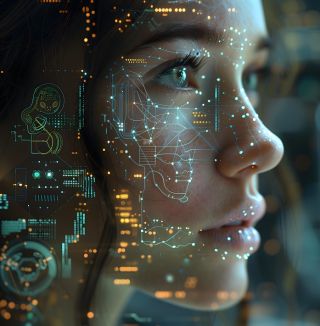Artificial Intelligence
Brain-Computer Interfaces Boosted by Novel AI Algorithm
AI deep learning may help decode behavior and mental states like depression.
Posted September 10, 2024 Reviewed by Abigail Fagan

The rise of artificial intelligence (AI) deep learning algorithms is helping to accelerate brain-computer interfaces (BCIs). Published in this month’s Nature Neuroscience is new research that shows how an AI algorithm can associate noisy brain activity with certain behaviors, an advancement that can help improve the performance of BCIs as well as find new patterns in neural activity. The AI algorithm was developed at the Viterbi School of Engineering at the University of Southern California in Los Angeles.
BCIs offer hope to those with disabilities due to stroke, spinal cord injury, Alzheimer's disease (AD), Parkinson's disease, amyotrophic lateral sclerosis (ALS), Multiple Sclerosis (MS), cerebral palsy, and other neuromuscular and neurodegenerative disorders.
The demand for BCIs is expected to increase as the prevalence of neurodegenerative disorders increases. Alzheimer's disease makes up the majority of dementia cases. By 2030, dementia will affect an estimated 78 million people worldwide and 139 million in 2050, according to Alzheimer’s Disease International. The BCI market size in 2024 is an estimated USD 2.3 billion and is expected to grow at a compound annual growth rate of 17.8% during 2024-2030 and reach USD 6.2 billion by 2030 according to Grand View Research.
Brain activity is a noisy environment and identifying patterns linked to specific behaviors is the holy grail for BCIs. Brain-computer interfaces, also known as brain-machine interfaces, are computer-based devices that enable people to communicate and control external devices using thoughts. Brain-computer interfaces pick up and decode signal patterns from brain activity, analyze and predict the user’s intended command, then transmit it to an external device to execute. Artificial intelligence machine learning algorithms play a key role in analyzing and decoding the massive amounts of noisy brain activity by finding patterns and predicting the BCI user’s intended command.
At any given moment, the human brain is actively engaged in a number of different behaviors. Having a way to identify and predict the user’s intended action for a specific task is an extremely challenging task that the pattern-recognition capabilities of AI machine learning can help analyze and decode for brain-computer interfaces.
There is a dizzying array of AI machine learning algorithms. Finding the best type to decode noisy brain data for BCIs is a daunting task. The four types of machine learning algorithms are ensemble learning, supervised machine learning, unsupervised machine learning, and reinforcement learning. Ensemble learning algorithms include stacking, boosting such as Gradient Boosting and AdaBoost, and bagging such as Random Forest. Supervised machine learning, or supervised learning for short, includes classification algorithms such as neural networks, gradient boosting, Random Forest, Naïve Bayes, Support Vector Machines (SVM), k-Nearest Neighbors (k-NN), logistic regression, and decision trees. Supervised learning also has regression algorithms such as Neural Networks Regression, decision trees regression, Ridge Regression, Support Vector Regression (SVR), Random Forest Regression, Gradient Boosting Regression, Least Absolute Shrinkage and Selection Operator (LASSO) regression, and linear regression. The major types of unsupervised machine learning, also called unsupervised learning, are clustering algorithms such as hierarchical clustering, k-Means, Gaussian Mixture Models (GMM), and Density-Based Spatial Clustering of Applications with Noise (DBSCAN), dimensionality reduction algorithms such as Uniform Manifold Approximation and Projection (UMAP), Linear Discriminant Analysis (LDA), Independent Component Analysis (ICA), t-Distributed Stochastic Neighbor Embedding (t-SNE), Principal Component Analysis (PCA), and association algorithms such as Eclat and Apriori. Reinforcement learning algorithms include value-based methods such as Monte Carlo and Temporal Difference (TD) Learning, model-based methods such as Trust Region Policy Optimization (TRPO), Deep Deterministic Policy Gradient (DDPG), and Proximal Policy Optimization (PPO), as well as model-free methods such as State Action Reward State Action (SARSA), Policy Gradient Methods like REINFORCE, Deep Q-Network (DQN), and Q-Learning.
There are also many types of artificial neural networks. Examples include convolutional neural network (CNN), long short-term memory (LSTM), multilayer perceptron (MLP), generative adversarial network (GAN), deep belief network (DBN), Self-organizing map (SOM) or Kohonen map, radial basis function (RBF), and recurrent neural network (RNN).
For this study, the researchers developed their model using a type of artificial deep learning neural network called recurrent neural networks (RNNs), a deep neural network used for natural language process, language translation, image captioning, and speech recognition. Recurrent neural networks are used for Apple’s Siri, Google Translate, and Amazon’s Alexa, for example.
The scientists called their AI algorithm DPAD, short for dissociative prioritized analysis of dynamics. It’s an AI tool for nonlinear dynamical modeling to help decode brain behavioral data. Nearly 70% of the custom code was written in Python, a multi-paradigm programming language, and the remainder used Jupyter Notebook, a web-based notebook environment for interactive computing.
What sets the DPAD algorithm apart from other recurring neural network algorithms used for decoding behavior from brain activity, is its ability to learn the mapping of the latent states to behavior and to brain activity. The team achieved this by having a second optimization step in their system architecture.
“This AI algorithm can help us discover how our brain gives rise to our behaviors such as movements and internal states such as moods,” said corresponding author Maryam Shanechi, Ph.D., the Dean's Professor and Founding Director of the new USC Center for Neurotechnology. “It will also help us develop brain-computer interfaces that provide potentially transformative therapies for brain disorders such as major depression or paralysis, which are a leading cause of disability worldwide.”
The study co-authors include Shanechi Lab research associate Omid Sani, Ph.D., and Bijan Pesaran, Ph.D., a professor of neurosurgery, neuroscience, and bioengineering at the University of Pennsylvania.
Copyright © 2024 Cami Rosso All rights reserved.




